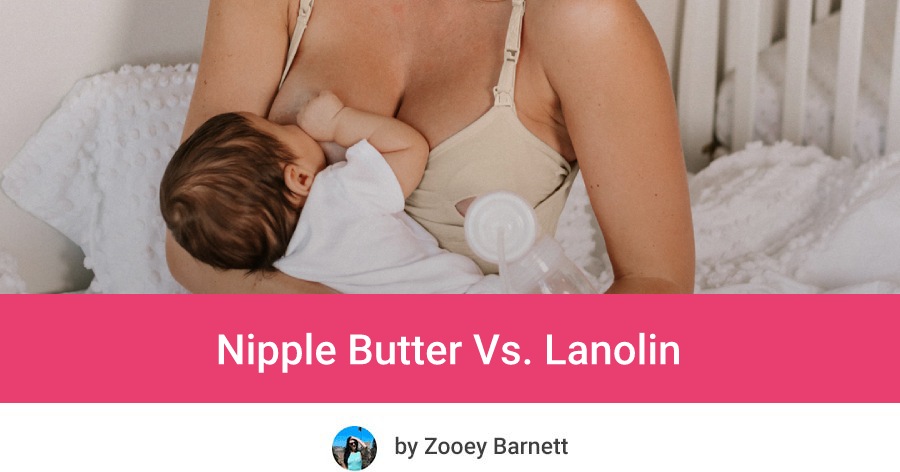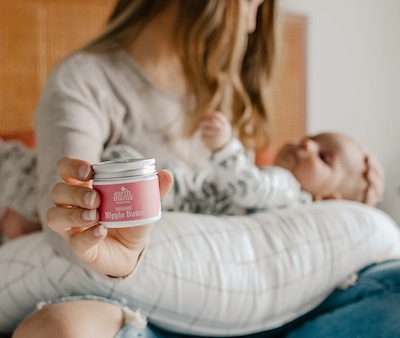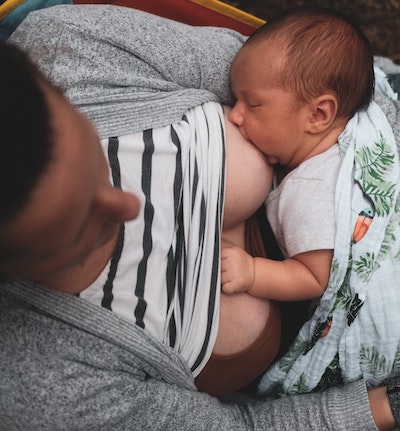Are you hesitating whether you should go for a regular nipple cream with lanolin, or if it’s better to opt for a lanolin-free organic nipple butter? In this article I’m comparison nipple butter versus lanolin. Keep on reading to find out which of these two is better for healing cracked nipples and safer for breastfeeding baby.

Article by Macy Tollefson – doula, breastfeeding specialist & prenatal yoga teacher
When new moms start out breastfeeding, many of them are shocked to find that it can be very challenging, and may come with a lot of nipple pain.
It is extremely common for women to experience sore, cracked and even bleeding nipples (especially in those first few weeks of breastfeeding), and painful nipples lead many breastfeeding moms to quit earlier than they planned to, because they just can’t cope with the pain.
Note: It’s very likely that your nipples will feel tender when you first start out (even with a proper latch), but it’s important that you know- breastfeeding should not hurt. Sore or cracked nipples are usually because your baby is not positioned optimally and is attached too shallow on your breast.
If you are experiencing persistent nipple pain while breastfeeding, I highly encourage you to talk to a lactation consultant for support. I know how frustrating it can be to navigate a painful breastfeeding experience, but just know that you don’t have to do it alone.
Dealing with painful nipples can be discouraging. Luckily, there are great products available to help soothe sore nipples and make your breastfeeding journey more enjoyable!
If you’re wondering what ingredients you should looking for in the best nipple cream to soothe your sore, cracked nipples, and make breastfeeding more enjoyable- you’re in the right place.
Here I’m going to discuss the differences between lanolin creams and lanolin-free nipple butters.
Nipple butter and lanolin are common products you’ll hear recommended for nipple healing, but which one is more effective? Which one can you keep on while feeding? And which one is safest for you and your baby?
Keep reading to find out what ingredients inside the best nipple creams are SAFE and bring immediate relief.
This article is not a substitute for medical advice.
What Is Lanolin?
Lanolin is a waxy substance that is found naturally in sheep’s wool1. Because it’s properties are so similar to sebum (the natural oil our skin produces), lanolin is a popular ingredient found in many moisturizers and other self-care products.
Lanolin can be found in lip balm, makeup, makeup remover, mustache wax, leathers, and even in baby lotions, baby oil, and diaper cream.
For a long time, lanolin nipple cream was the only option being recommended for moms to use, to heal their sore or damaged nipples. However, some people have allergic reactions to it, and it causes their nipples more pain and irritation.
An allergic reaction to lanolin may look like:
- Rash or itching where it was applied.
- Shortness of breath.
- Swelling of the throat, lips, eyes, or mouth.
If you are allergic to wool, your body is actually reacting to the lanolin found in the wool. Because of this, it may be best to avoid lanolin nipple creams if you have a sensitivity to wool.
Even if you don’t have a wool allergy, some people still find lanolin irritating, due to it’s toxic makeup.
Before extracting the lanolin, sheep are directly sprayed with pesticides, and the harvested wool is soaked again in pesticides (and other harsh chemicals) to “purify” it and remove any parasites.
Because of this, it extremely common to find traces of pesticides in lanolin products, even in the best lanolin nipple cream.

Is Lanolin Safe For Baby?
So, is lanolin safe for baby to swallow?
While the risk may be low, there is STILL a risk when it comes to your baby ingesting any amount of lanolin.
If there are traces of pesticides found in your lanolin product, it will be directly passed to the baby through their mouth. All pesticides have some level of toxicity in them, and therefore pose a risk to developing babies and children2.
Further, lanolin oil itself is actually poisonous when consumed, and can lead to vomiting, diarrhea, rashes, and skin irritation3.
And finally, lanolin’s consistency is similar to wax, so when ingested in high quantities, it can lead to intestinal blockages4.
For all of these reasons, it’s best to wipe off a lanolin nipple cream before feeding your baby or pumping5.
Some of the most popular lanolin creams are:
- Lansinoh Lanolin Nipple Cream.
- Medela Tender Care Lanolin Cream.
Why Is Lanolin Not Recommended For Breastfeeding Babies?
While these small amounts of toxins present in lanolin may not pose a risk to adults, babies have immature livers, kidneys and digestive systems. This means they may not be able to process out the impurities on their own.
So while it is considered “low” risk, there is still a chance that lanolin nipple creams can be harmful to your growing baby.
Even if you do not have sensitive skin or experience an allergic reaction from using lanolin nipple creams, the fact remains that there are much safer options available – including cruelty-free and organic nipple creams that are safe for baby to ingest.
What Is A Nipple Butter?
A nipple butter is an alternative to a lanolin based nipple cream, that tend to have different main ingredients.
They are made of a combination of edible oils and butters, and have a thick consistency. Their silky texture makes it easy to spread over skin and provides more intense moisture than a cream.
The difference between a cream and a butter, is that creams usually include more water in their ingredients, which typically requires a preservative to be added as well, to protect against bacteria growth.
If made with good quality edible and organic ingredients, breastfeeding moms don’t need to worry about wiping off a lanolin free cream before a feed – unless the packaging says otherwise.

What Does Nipple Butter Do?
A nipple balm provides a healing, moisturized layer for your damaged nipples to heal. It can be used before, during and after feeding or pumping, and reapplied as much as needed.
The healing ingredients and intense moisture soothe any irritation and pain that breastfeeding moms may experience.
You may also want to use it when you’re pregnant if you’re experiencing dry and crusty nipples (due to hormonal changes and breast enlargement).
When Do I Need Nipple Cream?
You’ll want to use a good nipple cream if your nipples need any soothing at all, whether they are simply feeling dry or tender, or if they are damaged and need a healing barrier.
A friendly reminder again: if you are experiencing persistent nipple pain, seek professional support. Even the best nipple creams will not take away pain that’s due to a poor or shallow latch.
Apply nipple cream if your nipples…
- Are damaged (cracked, bleeding etc.).
- Are dried out or chapped.
- Need a little extra lubrication on your breast pump flange.
Many nipple creams are actually an all purpose nipple ointment, and can be used on dry skin and cuticles too! Keep it in your diaper bag to be used whenever you are on the go.
Are Nipple Creams & Butters Safe For Breastfeeding Babies?
It depends – not all nipple creams are created equal.
If a cream contains preservatives like chlorphenesin or phenoxyethanol, it could pose a risk to babies. It’s important to read the ingredients on the nipple cream you hope to use, and do your research.
To be safe, stick to brands that have a commitment to organic, natural ingredients, and prioritize safety for both mom and baby.
The best organic nipple cream will be one that has a short list of ingredients, with its main ingredient being something soothing and baby-safe. For example, Earth Mama Organic uses cocoa butter as the main ingredient, Honest Nipple Balm uses coconut oil, and Motherlove Nipple Cream uses olive oil.
Here is our list of the best nipple creams for breastfeeding that are safe for babies (and you don’t need to wipe them off before feeding your little one).
Look for baby-safe ingredients, such as:
- Coconut oil
- Shea butter
- Extra virgin olive oil
- Cocoa butter
- Mango seed butter
- Calendula flower
- Organic marshmallow root
Do You Have To Wipe Off Nipple Butter Before Breastfeeding?
If a product instructs you to wipe it off before feeding your baby, it is best not to use it at all.
There are several nipple cream options that are SAFE for your baby to ingest, meaning you don’t need to wipe it off before feeding or pumping.
Look for organic nipple butter with Non-GMO Project Verified products, that have a short list of baby-safe ingredients. Most nipple creams of this nature are SAFE to leave on while breastfeeding or pumping.
Nipple creams that don’t need to be wiped off are WAY more convenient and won’t leave you worried about whether your nursing baby got any in their mouth.
If you are concerned about whether or not you can wipe a cream off and you’re in a pinch, play it safe and use your own expressed breast milk on your sore nipples instead! This is a great natural remedy, as it contains anti-bacterial, anti-fungal, and anti-viral properties, and of course, doesn’t need to be washed off.

What Ingredients Should I Avoid In Nipple Cream?
There are a few ingredients you should avoid when looking for a nipple cream. These include (but aren’t limited to):
- Alcohol – this will dry out the nipples, when we want to MOISTURIZE.
- Anesthetics – numbing agents, which could numb baby’s lips or throat.
- Unpurified lanolin.
- Petroleum or parabens – preservatives.
- Other unsafe preservatives – such as chlorphenesin and phenoxyethanol.
- Flavor or artificial fragrances – these may cause baby to reject your nipple.
What Is More Effective For Healing Sore Nipples: Lanolin Vs. Nipple Cream?
While there are varying opinions around the safety and effectiveness of lanolin nipple creams, multiple studies have shown there are MORE effective options, when it comes to healing damaged nipples.
One study found that breastmilk alone was more effective in treating sore nipples and discovered that the healing time was actually LONGER, when using a lanolin nipple cream5.
Another study found aloe vera to be superior to lanolin, and another concluded olive oil alone was more effective6.
More studies need to be done, but it is safe to assume that an organic nipple cream made with healing oils and butters (see list above for baby-safe ingredients), is likely to be MORE EFFECTIVE (and safer!) than lanolin – due to their healing and moisturizing ingredients.
Final Decision: Is Nipple Butter Or Lanolin Better & Safer For Breastfeeding?
All around, an organic, lanolin-free nipple cream is the BEST option for healing sore nipples from breastfeeding and pumping.
Choose a lanolin-free nipple balm that is USDA certified organic, to alleviate any worries about potential toxins being transferred to your baby.
Some of the best options are the Earth Mama Nipple Butter and the Motherlove Nipple Cream.
Article By Macy Tollefson
Macy Tollefson is a full spectrum doula, breastfeeding specialist and prenatal yoga teacher. She is passionate about guiding the modern mama on her journey through the beautiful (and wild) transformation of pregnancy, birth and postpartum. Macy envisions a world where every mother has access to the resources she needs, and follows her intuition to make the best decisions about what is right for her and her baby.
The purpose of this article is informative. It’s not a substitute for professional medical advice or medical care. Remember: safety first! Consult your doctor/pediatrician in case of any doubts. The author of this article does not accept any responsibility for any liability, loss or risk, personal or otherwise, incurred as a consequence, directly or indirectly, from any information or advice contained here.

